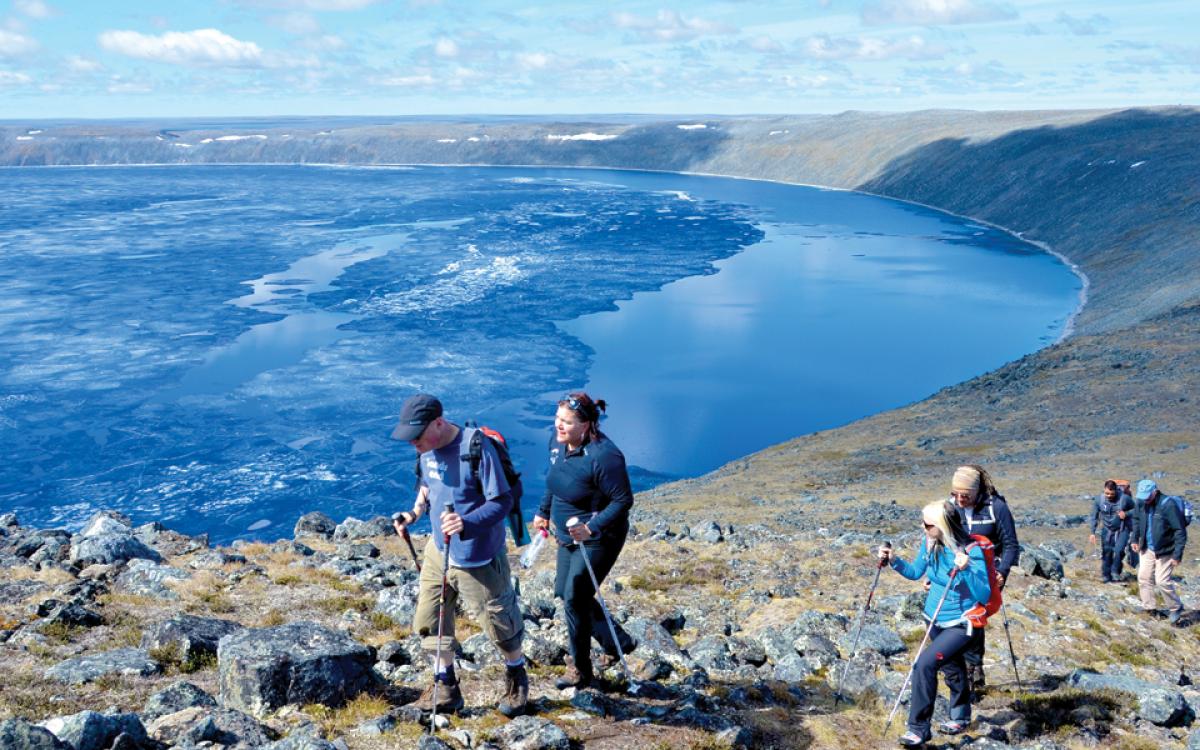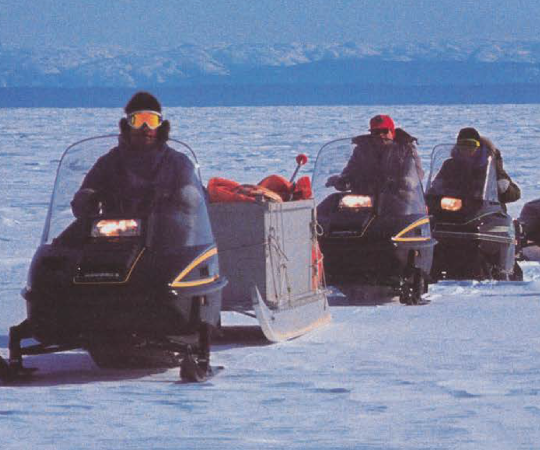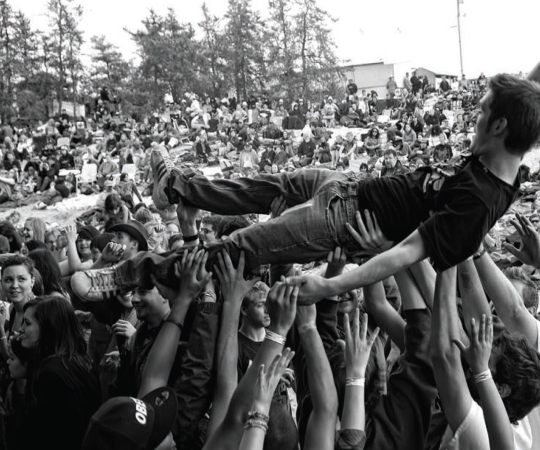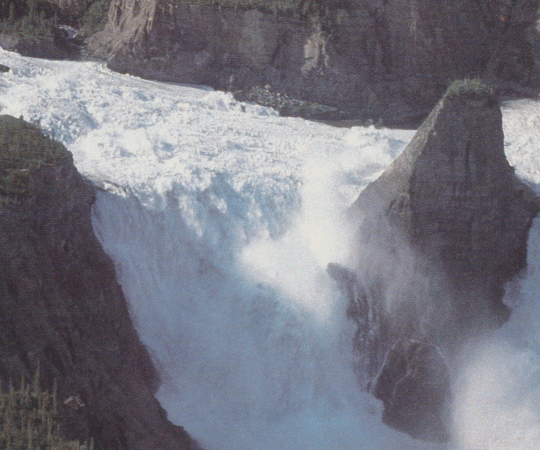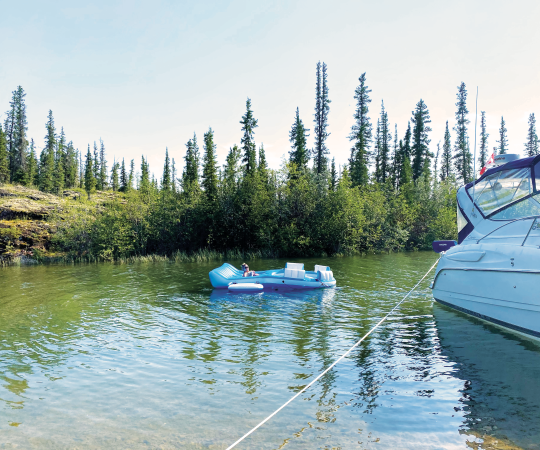Readers of this magazine will be familiar with the mountain hikes of the Yukon and the rollicking rivers that flow through the NWT and Nunavut, but the adventure doesn’t stop at the western shore of Hudson’s Bay. Nunavik, the top third of Quebec that sits above the 55th parallel, is just as adventurous and steeped in myth as the territories—but most people wouldn’t know it. Let Up Here introduce you to some of what this incredible land has to offer.
Pingualuit National Park
Hike: This national park was named after the Pingualuit Crater, 400 metres deep and 3,440 metres wide, created by a meteorite that smashed into the earth 1.4 million years ago. Inside the crater is pristine Pingualuit Lake. The water was nicknamed “The Crystal Eye” by Inuit long ago because the water is crystaline–tasteless, odorless, colourless and salt-free.
The trek around the crater is about 12 kilometres, and there’s only one spot where it’s safe enough to descend to touch and taste the crystal eye.
Only 10 kilometres away is the Puvirnituq River Canyon, home to gyr and peregrine falcons. Most fly in to Lake Manarsulik as their home base for this trip.
Paddle: The northernmost river in Quebec, Puvirnituq River (meaning “place where it smells like rotten meat” in Inuktitut) is separated into two legs. The Upper Puvirnituq hosts the river canyon, with 400-foot-high walls, and the chance to see falcons, wolves and caribou. It has many rapids, but is calmer than the Lower Puvirnituq River, which is described by paddlers as “a monster of energy,” “vicious,” and “strong as hell.” Expect to spend a difficult but breathtaking few weeks in the tundra.
The trip can be completed in 23 days, which allows for weather hold-ups and conditions that are unsuitable for paddling. The route is for advanced paddlers—there is no shortage of whitewater on this 413 kilometres of river. July is the best time to take this trip, as water levels should be at the perfect height to travel safely.
Depart from Raglan Lake (get there by traversing Vachon River, St. Germain Lake and St. Germain River) in Pingaluit National Park or from Raglan Mine, and come back to civilization on the coast of the Hudson Bay in Puvirnituq.
[view:image_galleries=block_1=2064]
Kuururjuaq National Park
Paddle: The Koroc River route begins at the base of the Torngat Mountains, and finishes 165 kilometres later in Ungava Bay. Like the Puvirnituq River it can be divided into sections: the first is calm; the second is 52 kilometres of almost constant rapids, including the 10-metre-high Korluktok Falls; and the third is flat water, save for the last stretch before the bay. Arctic char may catch your eye as they swim alongside you, but not as much as the switch in landscape from alpine vegetation to flat tundra. Like the Puvirnituq, the Koroc should be attempted in July to ensure your safety.
Hike: If paddling the strenuous Koroc River doesn’t interest you, why not hike it? The Koroc-Palmer loop is a common multi-day hike, but don’t get us wrong—with 1,000 metres of elevation gain, it’s a challenge. Departing from a gravel airstrip in the Koroc River valley, you will have 90 kilometres ahead—a route once travelled by Inuit of both Nunavik and Labrador. The most common animals along the trek are wolves, black bears and caribou. And when you’re onto the Palmer River valley section, prepare yourself for dramatic scenery: Steep cliffs contrast with towering mountains, plummeting falls and plenty of lakes.
Climb: In the Torngat Mountains, you can to see for miles: glaciers, the Koroc and Palmer rivers, tundra meadows, the Labrador Sea to the East, herds of caribou—and perhaps the Tivi Etook. According to local legend, the Tivi Etook is a spirit that resembles a polar bear; it emerges from the sea and roams through the Torngats on its hind legs.
Charter a flight from Kuujjuaq and prepare to scramble 1,650 metres up Mount Caubvick, the highest peak in Eastern Canada. It’s recommended you hire an alpine guide; there have been tragedies on the mountain before, so play it safe. For this expedition, you should be comfortable with navigation, physically fit and have adequate safety and survival skills. Allow for at least a week in the Torngats since the weather is unpredictable and can often foil expedition plans.
Tursujuq National Park
Paddle: This park was only established three summers ago, and adventurers are still exploring the 2.6 million hectares to see what it has to offer. The park has sturdy populations of seals, beluga, and birds of prey that nest in the region’s famous (and hikeable) cuestas.
The most popular excursion here is to paddle Tasiujaq Lake, a brackish body of water in Nunavik that was also formed by a crater. Nikki Gregg, paddler extraordinaire and host of Outside Television TV show Facing Waves, is among the few of the first non-Inuk adventurers to have explored Tursujuq Park—and that was just in 2015. “I wouldn’t recommend anyone going on their own,” she advises. “When it’s nice, it’s nice, but the weather can turn nasty pretty quickly.” She describes it as cold, challenging, rugged, isolated—the park made her “appreciate what she has in life.” Cold praise, but don’t mistake it for a bad review—she also describes it as the trip of a lifetime. She hiked the cuestas and saw a panoramic view of the park, came into contact with a herd of muskox and saw ancient Inuit relics, such as arrowheads, just lying around on the ground, waiting to be discovered.
Gregg doesn’t recommend Tursujuq to just anyone, but for those who do take it on, she says it will push you—and make you feel alive.
Paddlers beware: These river trips are for advanced paddlers. Make sure you have the right whitewater skillset, wilderness experience and—most importantly—make sure you’ve done your research before attempting them. But if you’re ready for these rivers, hit them hard and let us know how they were by writing to letters@uphere.ca

